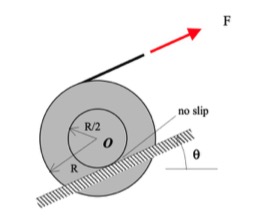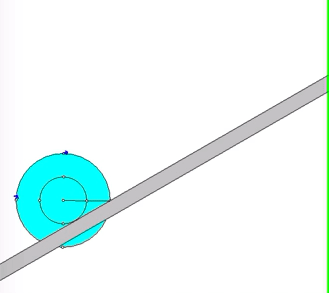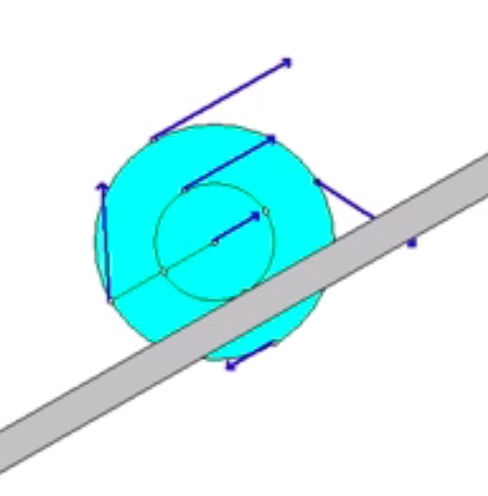| Problem statement Solution video |
DISCUSSION THREAD

Ask your questions here. Or, answer questions of others here. Either way, you can learn.
DISCUSSION and HINTS
The animation below shows the motion of the wheel as it is being pulled up the incline. The animation shows the velocity of a number of points on the wheel. Think about the location of the instant center for the wheel as it rolls without slipping, and how this location affects the direction and magnitude of the velocities shown here.

Recall the following four-step plan outline in the lecture book and discussed in lecture:
Step 1: FBDs
Draw a free body diagram (FBD) of the wheel.
Step 2: Kinetics (Newton/Euler)
- Looking at your FBD above, which forces, if any, do work that is not a part of the potential energy of the system? Pay particular attention to the friction force at the no-slip point on the wheel - does it do work? How do you find the work done by the applied force F?
- Write down the kinetic energy of the wheel. Recall that the expression the KE for the planar motion of a rigid body is: T = 0.5*m*vA2 + 0.5*IA*ω2, where A is either the center of mass or a fixed point (fixed points include instant centers). So, in this case you can use either O or the no-slip contact point (let's call that point C).
- Define your gravitational datum line. Write down the potential energy for the wheel.
Step 3: Kinematics
Use the IC approach to relate the velocity of the point on the wheel where the cable comes off (call that point A) to the angular velocity of the wheel. Or, instead, use the following rigid body kinematics equation:
vA= vC + ω x rA/C

Through a time integration of the relationship between the speed of A and the angular velocity of the wheel, you can determine the distance through which F moves.
Step 4: Solve
From your equations in Steps 2 and 3, solve for the angular velocity of the wheel at position 2.
This problem has a very similar set up to Example 5.B.2 in the lecturebook.
When it says that that point O moves a distance d up the incline, does it mean that point O moved up a vertical distance of d or it moved a distance of d along the incline?
I assumed it is moving up the incline.
I believe this is distance along the incline. I hope this helps!
Also, was this a typo? Under step 2, the second bulletpoint, it's written that T = 0.5*m*vA2 + 0.4*IA*ω2 . . . I think the 0.4 should be a 0.5
I think this was a typo. In the example 5.B.10 done in class, we wrote the equation as T=0.5*m*v^2+0.5*I*ω^2
Yes, that was a typo. Thanks for pointing out this. It has now been fixed.
For the expression for work, is the M the total moment on the rigid body? Or is it JUST the torque from the non-conservative force?
When attempting this problem, something that confuses me is the way the nonconservative work formula must be set up. Would the momentum part of the equation be zero since the force is not changing angle between position 1 to 2, or would it have a value since the force is applying a moment on the system?
Would there be a friction force opposing the applied force F in our FBD since it says the cable is non slip?
I believe so.
It is recommended that you include the cable in your FBD along with the wheel. With that choice, there are only four forces acting on the wheel+cable: the applied force F, the weight of the wheel, the normal force at the contact point and the friction force at the contact point. The friction between the cable and the wheel is internal and does not do work.
Is the work done by the applied force F*d?
The work done is the force F times the distance through which the end of the cable moves.
Please note that the end of cable moves through distance that is greater than the distance d moved by O. Consider that the contact point of the wheel with the ground is the instant center (i.e., the center of rotation) of the wheel.
I am a bit confused as to how we are supposed to find the distance that the end of the cable moves. Is it correct to solve for the angle of rotation in radians first with point O, then to use that angle to solve for the distance the cable travels at a further radius with the same angle?
If you are talking about the part to find work. I found it helpful to look at the ratio of the bigger radius to the smaller radius. Thus helping me to find the total distance. Hope this answers your question.
When trying to find the work done by the applied force can we say the the force acts at the point where the cable is attached at the top of the wheel and then find the distance that the top of the wheel travels? If not how do we find the distance that the end of the cable travels without knowing anything about the length of the cable or how much cable is pulled off the wheel?
Please review the solution video of Example 5.B.10. The kinematics of this problem and of 5.B.10 are very similar in the determination of the work done by the applied force F.
We don't need to know anything about how much the cable was pulled because we know that the compound wheel is rolling without slipping. As a result, we just need to express the distance the top of the wheel travels in terms of the distance that the center of the wheel travels which we are given. The easiest way in my opinion is by relating the velocities, because the displacements are directly proportional to the velocities. Let's say we find that V(outer) is X times greater than V(Center), then we know that D(Outer) is X times greater than D(Center) which happens to be "d" in this problem. Hope this helps!
Notice that the work done by the applied force will not be Fd, rather it will be Fx. You will have to convert x into d, using a simple relation using the radii.
Is it correct to say that v_c is zero since the wheel is rolling without slipping? Futher, does this mean that work done by the friction force against the incline is zero, since the point of contact is constantly changing over distance d?
Yes, v_C = 0 and the friction force on the wheel at C does not do work (since C is instantaneously not moving).
Does the work energy equation with contains velocity have to be taken about a single point? Or can you do it for the whole disk ?
The kinetic energy expression for a rigid body includes, in general, both translational and rotational terms. If you choose a fixed point as the reference point, then all that remains is a rotational term.
This problem is very similar to example 5.B.10 in the lecture book. The key to this problem is the kinematics part of the solution since it will be used to find the distance that the Force F moves through. The rest of the problem is pretty straightforward with the Work-Energy method.
Don't forget potential E, I did at first and it messed my equation up
Look through example 5.B.10 before working this problem, it is very similar and will help guide you through the concepts.